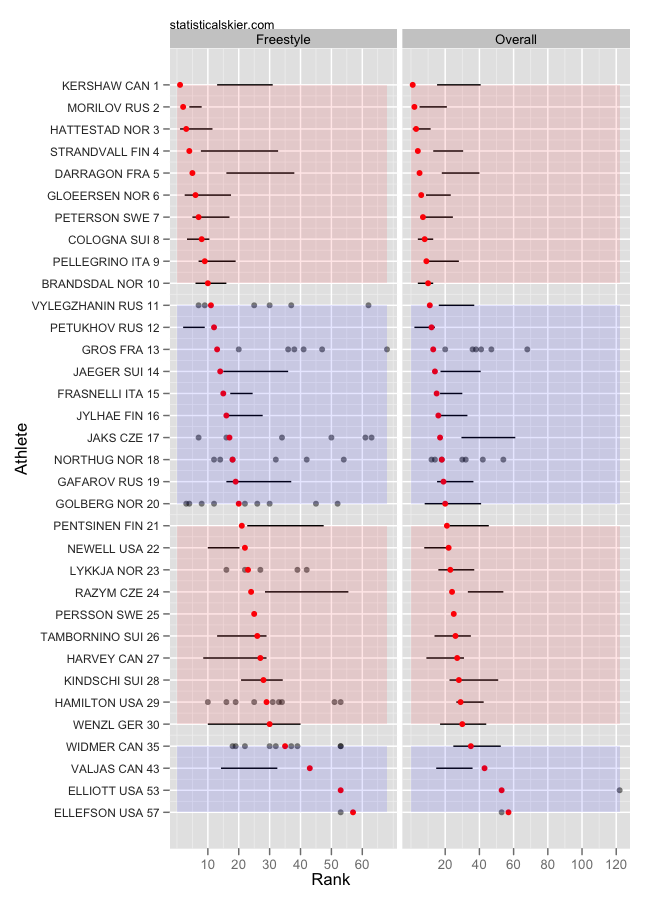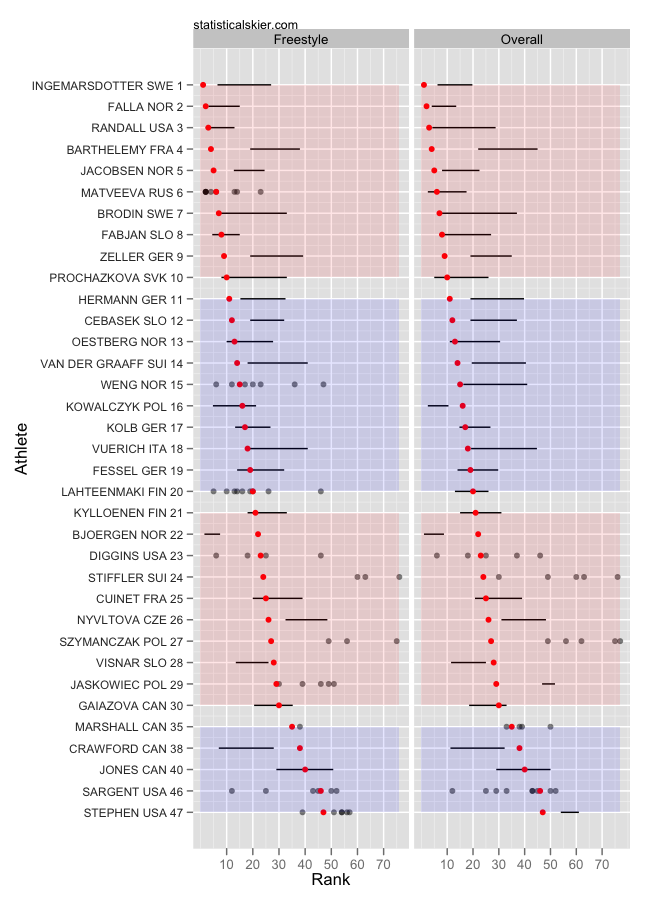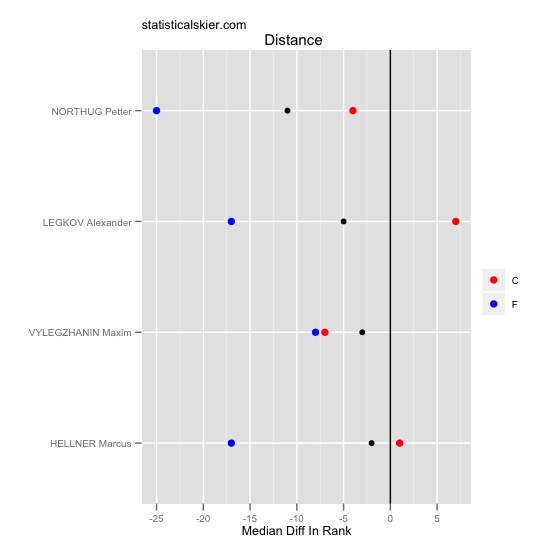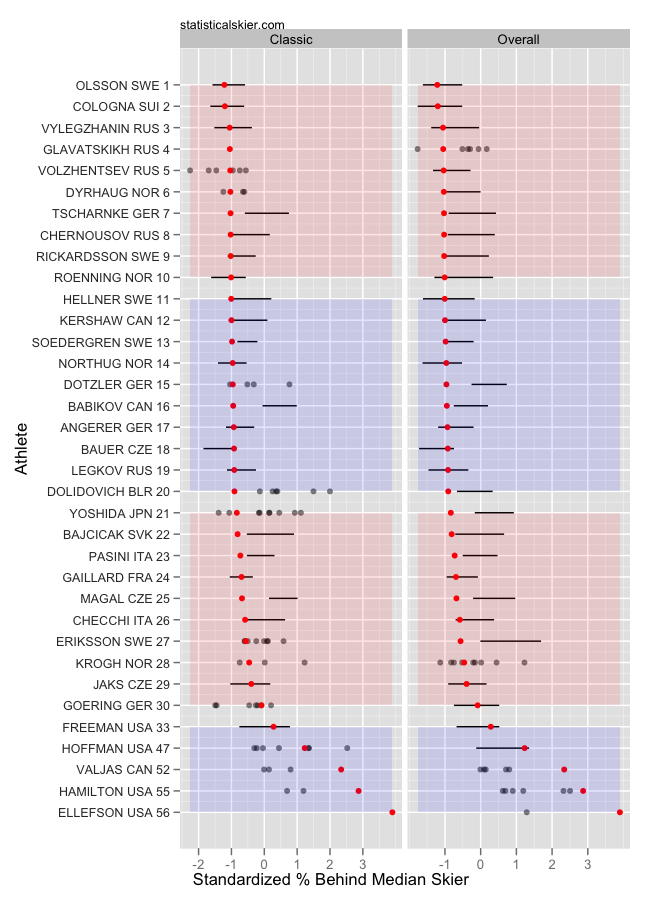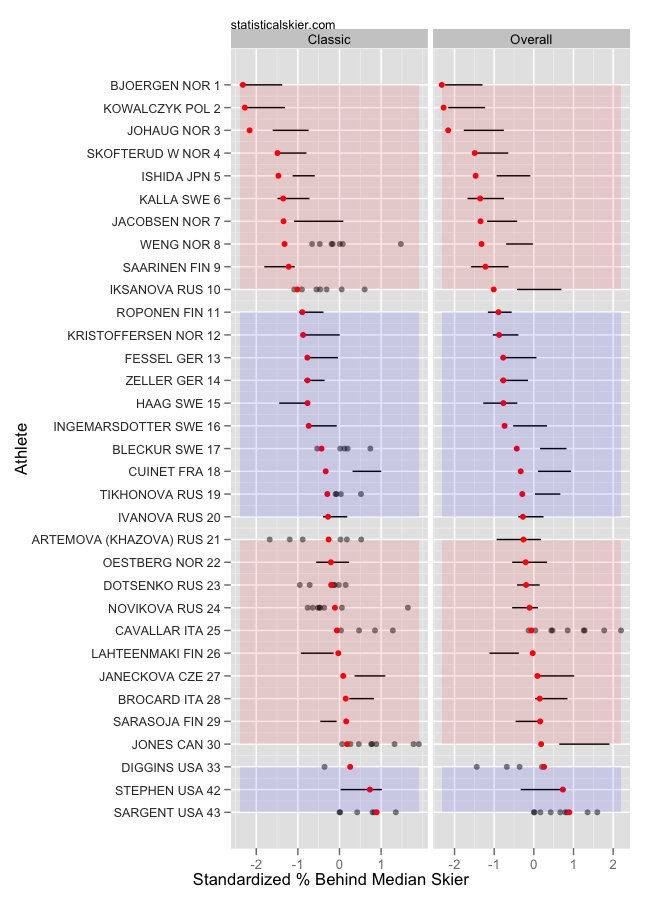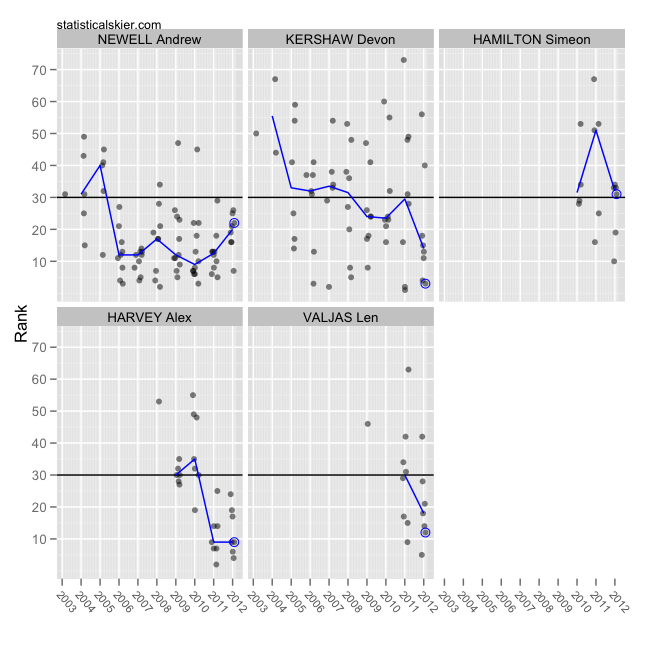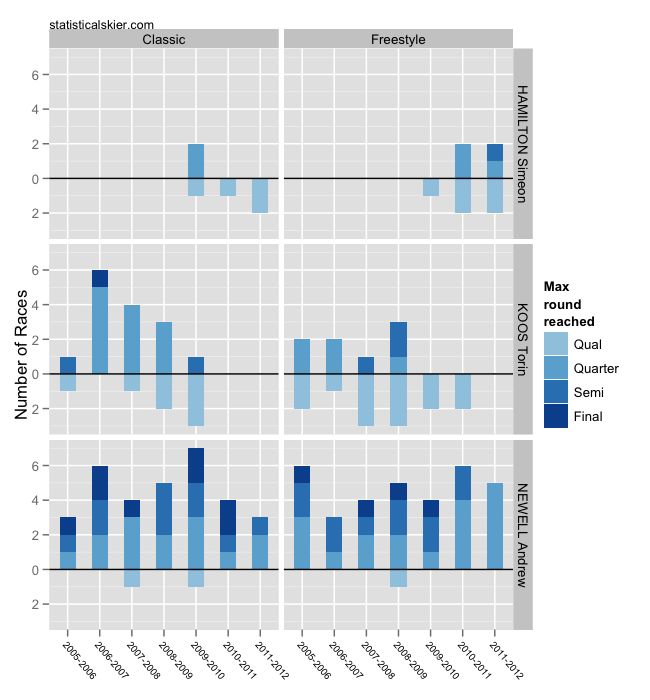Pages
- Race Snapshot: TdS Continuous Pursuit 4 views
- Dope Slap 3 views
- Running: What’s The Relationship Between Distance And Pace? 2 views
- WJC Preview 2 views
- Week In Review: Friday Feb 25th 2 views
- Race Snapshot: IBU WC Men/Women Sprint 2 views
- How’d We Do? USA/CAN Season Review 4 1 view
- Race Snapshot: TdS Final Climb 1 view
- USST Preview: Liz Stephen & Morgan Arritola 1 view
- Handicapping WSC 10/15km Freestyle 1 view
Tags
Age Analysis biathlon bump chart canada classic cycling Davos development devon kershaw Distance fis points freestyle giro d'italia kikkan randall kris freeman kuusamo liz stephen marit bjoergen mass start men most improved norway olympics pursuit race snapshot recap retirement retrospective season preview sochi Sprint stage race sweden tour de france tour de ski U23 USA usst wbc week in review WJC/U23 women World Cup WSC
Follow-Up On Devon Kershaw + World Cup Overall
A commenter on Monday’s post noted that there are some folks fairly close behind Kershaw in the WC overall, so he has more to worry about than just catching Petter Northug. In particular, Marcus Hellner is only 57 points back, while Alexander Legkov is fully 168 points back. Hellner is obviously the more immediate concern, but you can’t really count out Legkov. Then you have Maxim Vylegzhanin 270 back.
I’m going to approach this a bit differently than my last post. Starting with the schedule, we see that the end of the season is pretty heavily weighted towards classic skiing all around. We have 6 classic events, 2 (and a half) freestyle events and the pursuit. (The ‘half’ is the last stage of the World Cup Final, which apparently doesn’t count for WC points itself, but does contribute to the overall stage results.)
The good news for Kershaw is that he has tended to fare better against these guys in classic distance races, as compared to freestyle distance races:
Positive values here are better for Kershaw. So not only does he tend to do better against these four guys in classic races, the difference swings the most in his favor (although just barely in his favor) against Hellner and Legkov, his closest competitors.
On the other hand, basically the reverse is true for sprinting: Continue reading ›
Tagged alexander legkov, devon kershaw, marcus hellner, maxim vyleghanin, men, overall, petter northug, points, World CupCan Kikkan Randall Win The Sprint World Cup?
Recall that at the start of the season, I considered this question with a bit of skepticism. I was definitely more skeptical about her prospects than some others. Hopeful, but skeptical.
My skepticism stemmed from the fact that while Kikkan is arguably the best freestyle sprinter in the world right now, her classic skiing has traditionally lagged a bit behind. Based on the only experience I have, which is looking at lots and lots of results patterns over time, I was skeptical that she could improve her classic sprinting that dramatically.
So what has happened so far? Continue reading ›
Tagged justyna kowalczyk, kikkan randall, natalia matveeva, Sprint, World CupCan Devon Kershaw Overtake Petter Northug In The WC Overall?
That was the question in a comment I got the other day.
So here’s the situation. Devon Kershaw currently has 953 WC points, Petter Northug has 1199. Northug is apparently going to skip the next two weekends of WC racing in order to prepare for the Vasaloppet. Could Kershaw catch and overtake Northug in that time, and then hold onto second place through the rest of the WC season?
There is a ton of uncertainty in answering questions like this, so bear with me as I make some assumptions. Specifically, let’s assume that,
- Northug skips the WC races in Poland and Lahti, and also the Drammen sprints, but contests every remaining race on the schedule.
- Kershaw skis all the remaining races on the schedule.
Northug will be missing three sprints and two distance races. The remaining races consist of one sprint (Stockholm), three distance races (Oslo, first two stages of World Cup Final) and the World Cup Final overall stage results. (I’m not quite sure why the final handicap start stage of the World Cup Final isn’t listed in the WC points PDFs. In keeping with FIS’s sclerotic approach to race formats and scheduling this would be the only stage race event that doesn’t award WC points.)
So presumably Kershaw would have to make up the point gap, plus some breathing room since we probably can’t expect him to beat Northug in every remaining WC race.
The gap is currently 246 WC points. How many points above this would he need to feel safe in keeping Northug at bay?
So far this season when they’ve raced directly against each other, Northug has scored an average of about 13 more WC points per distance race and around 6 more WC points per sprint race. (I checked whether I needed to track point differences in regular vs stage WCs separately due to the different point scales, but the numbers turn out more or less the same.)
Naively carrying that forward would suggest that Kershaw would need a cushion of at least 45 WC points, not including the WC points awarded in the WCF overall. If we assume that Kershaw is unlikely to finish ahead of Northug in those overall standings, we’d need to tack on another 20-30 WC points as a conservative estimate.
So at the end of the day, let’s call that a grand total of around 315 WC points that Kershaw would need to pick up in the next three weekends alone.
That would mean averaging around 63 WC points for each of the next five races, through Drammen. (Third place is worth 60 points.) So if Kershaw really wants to control his own destiny here he doesn’t have much room for even the occasional 4th or 5th place finish.
However, due to the extremely non-linear nature of WC points, small changes in each athlete’s schedule, or a handful of unusually good or bad performances could alter this number considerably.
Suppose, for instance, that Northug wrecks himself in the Vasa, and develops some sort of minor illness. Then when he returns he’s a little flat and and has 1-2 really poor performances, outside the top 15. In this scenario Kershaw would have to pick up fewer WC points than the current gap of 246, since he’d still be outscoring Northug in the final four races.
So if you toss the assumption that Northug will continue to ski as well as he has the rest of the season, things look vastly more optimistic for Kershaw. He could conceivably only need to pick up 200 WC points while Northug is absent. He could probably do that in five races with a string of top tens, and the occasional podium.
In the end, though, you sort of have to put your money on Northug here. As the guy with the lead at the moment, and also just the stronger skier overall, he’s the one with the room for an occasional bad race or misstep. No matter what Northug does, Kershaw’s the one who’ll have to ski more or less flawlessly in basically every single remaining race. Which doesn’t leave much room for error.
Tagged devon kershaw, petter northug, World Cup, world cup pointsKershaw & Koos: Sprinting
A couple quick notes about some sprinting results.
Devon Kershaw
Kershaw’s having a heck of a season. On of the things I’m been most impressed with is how much his sprinting has improved, which is something I feel like hasn’t been mentioned much in a lot of the coverage:
The circled result in the most recent Moscow sprint. Notice how while Kershaw’s median sprint result was improving somewhat between 2006 and 2010, his best result was actually getting somewhat worse each season. Then he had a very inconsistent season of sprint results last year. He hasn’t completely solved his occasional poor qualification effort problems, but look at how much better and more consistent his results are this season.
I threw all those other guys up there just for comparison.
I’m a little concerned about Newell. This will mark the second season in a row of his median result moving in the wrong direction. He still has no trouble qualifying, generally speaking, but for a guy with a reputation of struggling to advance through the heats, that trend is worrying. Len Valjas is qualifying much more consistently, which is a significant improvement.
Koos
I made the graph below several weeks ago around US nationals, but have been somewhat hesitant to post it. Once again, Torin Koos won a US Nationals sprint race and (kinda) won the other as well. Ever since Koos left the USST, every time he skis well domestically there’s lots of chatter from his fans about how crazy the USST was to kick him off, etc.
While I appreciate that Koos has a lot of fans (and deservedly so) I feel like a lot of the outrage I see expressed on his behalf assumes that his international results were more accomplished than they really were. Here’s what I mean:
This plot show the number of WC level sprint races (truncated at 2006 to consider a single race format with 30 qualifiers) where each skier advanced to a particular round.
So for example, it shows that for Simi Hamilton, in classic sprints, did 3 WC level sprints in 2010. Twice he advanced as far as the quarterfinals and once he only skied the qualification round. The bar segments for the qualification round are inverted to indicate that that’s generally a bad result.
Newell, as you might expect rarely fails to qualify for the elimination rounds, but only occasionally reaches the finals. This season (so far) appears to be worse than usual on that front.
In freestyle sprints, Koos was failing to advance past qualification around half the time, and never made it past the semis. But the real story are his classic results, which were on a dramatic decline after 2007. As it was, it wasn’t like he was advancing past the quarters all that much.
I want to be clear here that my point is not that Koos’s results were bad necessarily, just that I don’t think they were as good as a lot of his fans think they were, and that there was clear evidence that they were trending in the wrong direction.
One of the most awkward and uncomfortable aspects of running this blog has been talking about US and Canadian skiers who have either had bad results, or who’s results are not as good as conventional wisdom would suggest, in my opinion. Â Which is a little weird, because it’s not like I actually know any of these folks. But since I have swum in those general waters, we surely have friends in common, so it still feels awkward for me. I’m not sure why I point this out except that maybe it soothes my conscience a little bit.
Tagged devon kershaw, sprinting, torin koosRybinsk Field Strength And The Resurgent US Women
Two topics today.
Rybinsk Field Strength
I’m including the Moscow sprints here, but generally these races are notorious for low attendance. They require some of the most travel for many of the Europeans and they are often scheduled very near the Scandinavian nation’s national championships.
Did this year’s races attract a stronger or weaker field than in the past?
This is hard to measure objectively, since there are a million different ways you could go with quantifying “field strength”. Here’s one simple take:
This shows the proportion of the top thirty skiers that season (up to the Russian World Cups) who attended.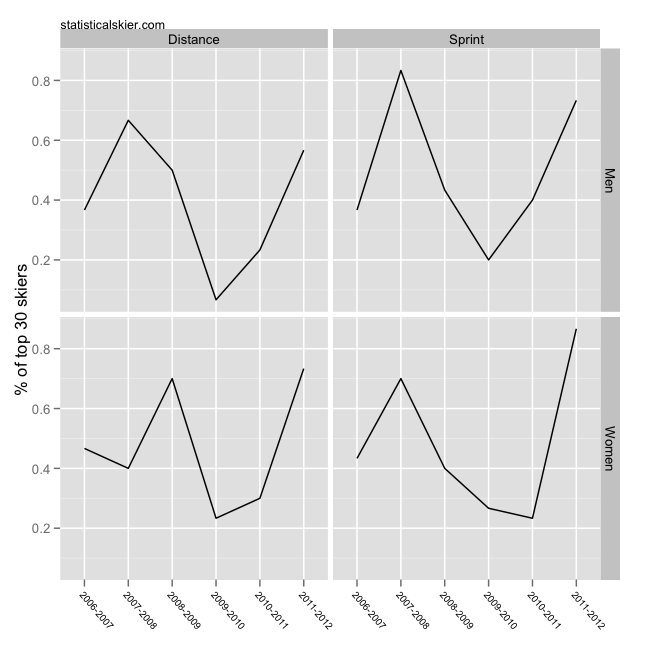
The measures FIS has been taking has definitely improves things since the embarrassing 2009-2010 races. The men’s fields have been getting more competitive at these races for two straight seasons now. The women’s sprint field took a huge jump this season. They weren’t all the most competitive the Russian races have been in the past (at least by this measure) but they’re about as good as we’ve seen. Continue reading ›
Tagged kikkan randall, rybinsk, USA, women, World Cup